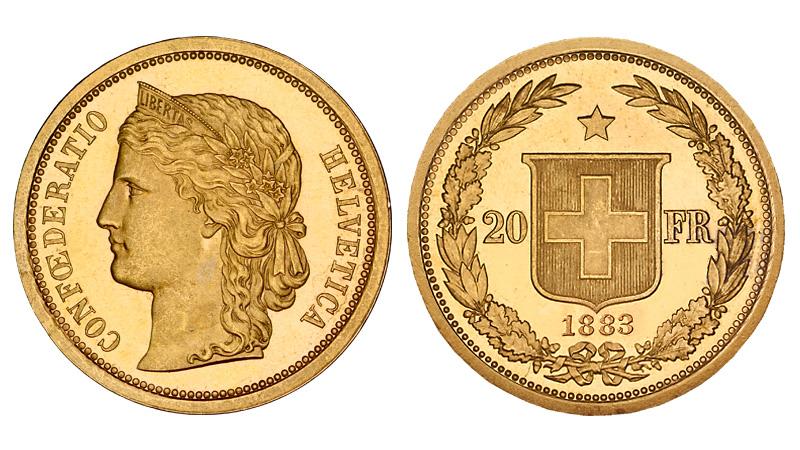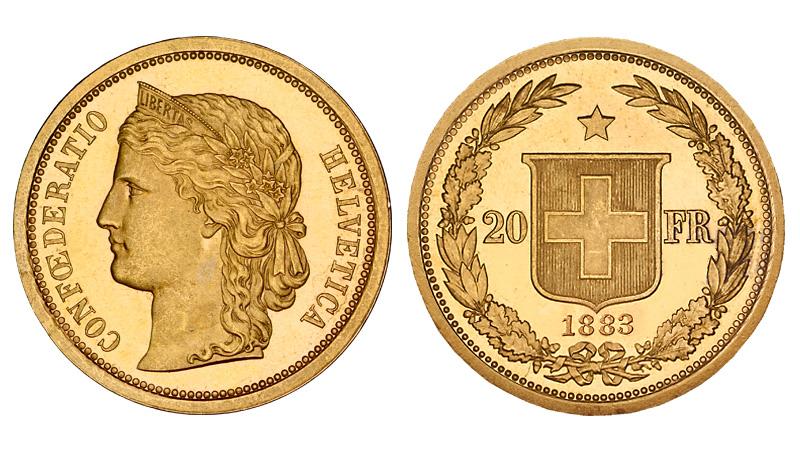Note: PreMeSec provides the metal value based on the market value of the precious metal for informational purposes only. PreMeSec.ch does not trade in precious metals itself. The price data is provided by third-party companies and updated several times an hour. PreMeSec.ch is not liable for the accuracy of the information and does not provide any trading or investment recommendations. Users of the trading platform are free to set their own prices; PreMeSec has no influence on these and accepts no liability.
The most important facts about the Helvetia coin in brief
The 20 franc gold coin is a Swiss currency coin that was minted from 1883 to 1896.
The mintage of the Helvetia gold coin was 1,745,000.
Today, its gold value exceeds the market value of 20 francs by more than ten times.
History of the Helvetia gold coin
The Federal State of Switzerland began minting its own coins in 1850, initially exclusively silver coins. In 1865 Switzerland became a member of the Latin Monetary Union, which fixed the franc at 4.5 grams of silver or 0.290322 grams of gold. It was not until 1983, under pressure from the other member states of the Union, that the first Swiss gold piece of 20 francs was introduced. The obverse depicts the head of Libertas, an allegory of freedom. The woman depicted is often referred to as Helvetia, despite the inscription on her diadem "LIBERTAS", which is why the coin is often found in shops under the name Helvetia. This coin is the predecessor of the gold Vreneli.
The Helvetia was minted from 1883 to 1896 and was replaced by the so-called gold Vreneli from 1897.
The end of the Latin Monetary Union in 1910 and the world economic crisis in the 1920s and 1930s resulted in a devaluation of all currencies. Due to this devaluation, the gold coin Helvetia lost its original purpose as a payment coin and was henceforth hoarded for investment purposes.
The gold-silver ratio at the time of the minting of the gold coin was about 15.5, whereas today it is at a much higher value of around 70. The gold-silver ratio thus describes the ratio of the value of gold and silver. At that time, 0.290322 g of gold corresponded to the value of 4.5 g of silver, but today you get about 20 g of silver for this amount of gold.
Appearance of the 20-franc Helvetia gold coin
The obverse shows the already described female head of Libertas flanked by the words "CONFŒDERATIO" and "HELVETICA". The hair is adorned by a diadem and alpine roses.
The reverse shows a Swiss coat of arms, above it a star, to the left of it the number 20, to the right a "FR", which stands for the currency franc. Below this is the year of minting. The whole is framed by a laurel and oak wreath, which in turn is enclosed by a pearl circle.
The edge of the coins from 1883 is ribbed, all later coins have a Latin inscription on the edge: "DOMINUS*** / PROVIDEBIT / **********" which means "The Lord (God) will provide".
Helvetia gold coins made of Swiss gold
Switzerland has iron, coal, salt and gold in its mountains. The deposits are smaller and mining more expensive than elsewhere. In the 19th century, however, there were gold mines in the canton of Ticino and in Valais. In 1893, 25 and in 1895 19 Helvetia coins were minted from gold from the Gondo mine in Valais. Since these coins were not alloyed with copper but with silver, these issues are lighter in colour than the other coins. Due to their small number, these coins are particularly valuable numismatically and are traded for tens of thousands of francs. As a special identifying feature, a cross was also punched into the Swiss cross.
Significance of the Helvetia gold coin today
Today the coin is only held for investment purposes.
While its successor, the gold Vreneli, is often traded, this coin is no longer available at many banks. If a bank offers this coin, then only with a spread of about 15%.
However, because of the smaller amount of gold compared to popular ¼ ounce (7.776 g) versions of common bullion coins, the coin is still suitable as a gift for a birthday, christening or wedding.
Image rights: © Swissmint
Register and sell Helvetia 20 Franken (1883 - 1896)Technical data
Similar products





